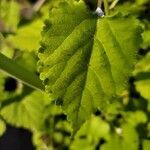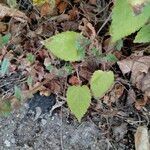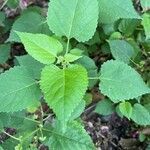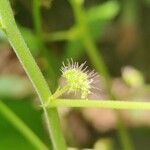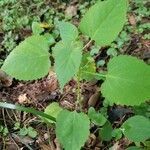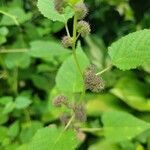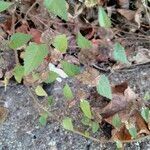Herb or subshrub to 1 m high; rootstock present; leafy stems puberulous and with longer hairs. Leaves distichous; lamina ovate, narrowly to broadly ovate to triangular, to 7 (–8.5) cm long, to 4.4 cm wide (1–4.5 × 1–4 cm, fide Zich et al. 2020), rounded to cordate at base, dentate margin, acute to acuminate at apex, chartaceous, sparsely armed with short stiff hairs; lateral veins 6–8 pairs; petiole (0.7–) 1–3 (–4.5) cm long. Inflorescence subcapitate, 0.3–1 cm diam., shorter than leaves; peduncle 0.5–2.5 cm long, puberulous. Male flowers pedicellate; tepals 4; stamens 4; pistillode minute. Female flowers subsessile; tepals 4 or 5. Endocarp body c. 0.8 × 0.6 mm. Wheeler (1992: 77) describes the achene as stipitate, obliquely globular to trigonous, c. 1 × 1.5 mm , with two rounded tuberculate faces and one ± flat smooth face.
Herbs , to ca. 8 dm. Stems erect, branched, pubescent with hooked trichomes. Leaves: stipules linear to linear-lanceolate, 1.8-2.5 mm; petiole 1-6 cm, often ± as long as leaf blade. Leaf blade to 2.5-10 × 1-7 cm, papery, base cordate to truncate, margins crenate-dentate, apex acute to acuminate; surfaces abaxially and adaxially appressed-hirsute. Inflorescences cymes, dense, 4-8 mm wide, subtended by narrow bract; peduncle 1-2 cm. Flowers light green, staminate and pistillate in same cyme. Staminate flowers: calyx campanulate; stamens exserted. Pistillate flowers: calyx boat-shaped; ovary globose, puberulent, somewhat depressed in axis; style reddish purple, filiform. Achenes white, oval, 3-angled, ca. 1 mm, minutely muricate, with 2 triangular, membranous appendages. Seeds explosively expelled.
Herbs, annual, 30-80 cm tall. Stem erect, few branched or unbranched, green when young, dark with age, puberulous. Petiole puberulous; leaf blade ovate to broadly ovate, 5-10 × 3-5 cm, membranous, appressed hirsute, base cordate to truncate and decurrent on petiole, margin crenate-toothed, apex acute; secondary veins 3 or 4 on each side of midvein. Inflorescences bisexual, cymose, ca. 5 mm wide. Male flowers: calyx lobes ca. 1 mm; stamens exserted. Female flowers: ovary ± depressed globose; style filiform, 1-1.5 mm, 2 × as long as ovary. Achenes ovoid, 3-angled, ca. 1 mm. Fl. May-Aug.
A herb which grows from seed each year. It is 30-80 cm high. The stems are green when young. It has few branches. The leaf stalk is hairy. The leaf blade is oval and 5-10 cm long by 3-5 cm wide. The leaf is like a membrane. The base is heart shaped and clings to the leaf stalk. There are teeth along the edge. Flowers are of 2 sexes. The fruit is dry and oval and 3 angled. It is about 1 mm across.
